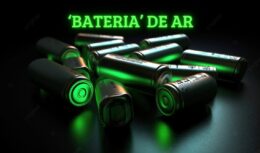
Creation allows solar cells to be installed in the windows of homes and offices, generating electricity from sunlight, without wasting it
At Penn State University, in the United States, a group of researchers is carrying out a very impressive project for charging with solar energy. It is a new electrode that considerably improves the efficiency of this technology. This protagonist has already gone around the world thanks to its technology, since, in addition to improving efficiency, it is transparent and has a golden energy conduction.
Read also
- Robot that plants and weeds promises to revolutionize the world of renewable energy in agriculture
- The world's first concept for rechargeable cement-based batteries appears and promises to revolutionize the generation of renewable energy in the world of civil construction
- The world's most powerful tidal (or tidal) turbine is ready and will revolutionize the world of renewable energy
- Giant offshore turbines will drive down the price of wind power, allowing wind to play a bigger role in the world's renewable energy
- Portable bladeless wind turbine for urban spaces could revolutionize renewable energy generation in the world

The development of new ultrathin metal electrodes has allowed researchers to create semitransparent perovskite solar cells, which are highly efficient and can be coupled with traditional silicon cells to greatly increase the performance of both devices, an international team of scientists said. The research represents a step towards the development of completely transparent solar cells.
"Transparent solar cells could one day find a place in windows in homes and office buildings, generating electricity from sunlight that would otherwise go to waste," said Kai Wang, assistant research professor of materials science and engineering at Penn State and co-author of the study. “This is a big step forward – we finally managed to make efficient, semi-transparent solar cells.”
Traditional solar cells are made of silicon, but scientists believe they are approaching the limits of technology in March to create ever more efficient solar cells. Perovskite cells offer a promising alternative, and stacking them on top of traditional cells could create more efficient tandem devices, the scientists said.
Perovskite solar cells are a breakthrough for renewable energy
"We've shown that we can make electrodes from a very thin, almost tiny atomic layer of gold," said Shashank Priya, associate vice president for research and professor of materials science and engineering at Penn State. “The thin layer of gold has high electrical conductivity and, at the same time, does not interfere with the cell's ability to absorb sunlight.”
The perovskite solar cell the team developed achieved 19,8% efficiency, a record for a semitransparent cell. And when combined with a traditional silicon solar cell, the tandem device achieved 28,3% efficiency, versus 23,3% for the silicon cell alone. The scientists reported their findings in the journal Nano Energy.
“A 5% improvement in efficiency is huge,” said Priya. “That basically means you're converting about 50 watts more sunlight for every square meter of solar cell material. Solar farms can consist of thousands of modules, so it adds up to a lot of electricity, and that's a huge step forward.”
Idea worth gold
In previous research, ultrathin gold film showed promise as a transparent electrode in perovskite solar cells, but problems creating a uniform layer resulted in poor conductivity, the scientists said.
The team found that the chromium used as a seed layer allowed the gold to form on top in a continuous ultrathin layer with good conductive properties.
"Typically, if you grow a thin layer of something like gold, the nanoparticles will stick together and come together like little islands," said Dong Yang, research assistant professor of materials science and engineering at Penn State. “Chromium has a great surface energy that provides a good place for the gold to grow on top of, and it really allows the gold to form a continuous thin film.”
Perovskite solar cells are composed of five layers and other materials tested, such as damaged or degraded transparent electrodes of the cells. The scientists said that the solar cells made with the gold electrodes are stable and maintain high efficiency over time in laboratory tests.

"This advancement in the design of tandem cell architecture based on a transparent electrode offers an efficient route to transition to perovskite and tandem solar cells," said Yang.
Also contributing to this research from Penn State are Tao Ye and Jungjin Yoon, postdoctoral fellows; and Yuchen Hou, a doctoral student.
Xiaorong Zhang, Shaanxi Normal University, China; Shengzhong Liu, Chinese Academy of Sciences; Congcong Wu, Hubei University, China; and Mohan Sanghadasa, US Army Combat Capabilities Development Command. USA, also contributed to the research.
The Office of Naval Research, the Army Rapid Innovation Fund, and the Air Force Office of Scientific Research provided funding for this research.












Air Force F-16 fighters…
True friend, what they shot down were…
Air Force F-16 fighters…
I would like to know what planet you live on…
Air Force F-16 fighters…
Everything is fine, 100-year secrecy,…
Air Force F-16 fighters…
Well... It's flying scrap... Typical...
Air Force F-16 fighters…
Which genocide are you talking about? Than…
I am a Maintenance Boiler and Industrial Plumber
I am ex military
What nonsense. Deceive muggles. The government comes…
If it's true, I'll buy two a lot...
Excellent article! Now where are the quotes…
I am I am eagle
Forward Brazil
These little people... That's why transport...